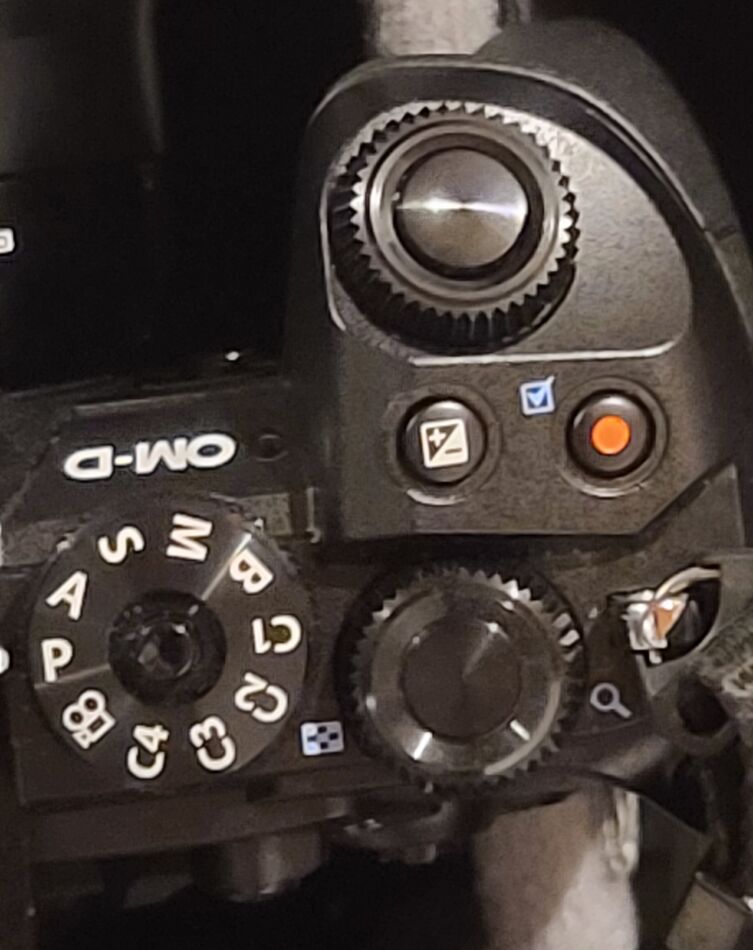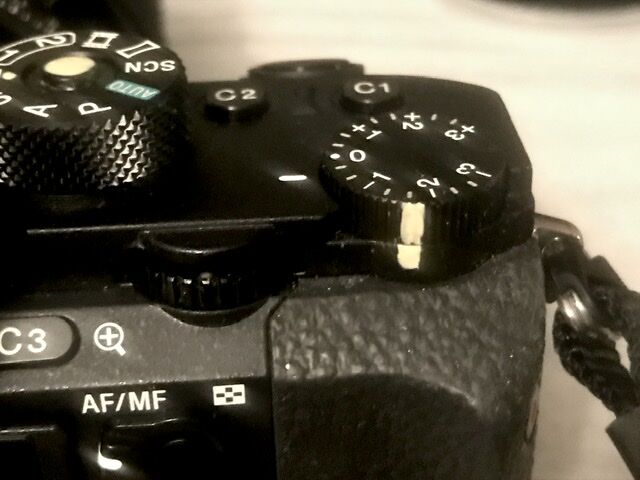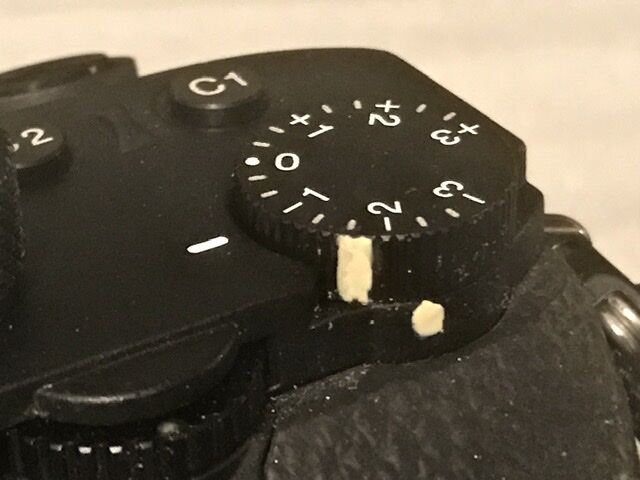Why would you use the exposure compensation dial?
Nov 27, 2022 14:32:35 #
stan0301 wrote:
Forget to set it back is sure what I did - I think it is just a reflection of the fact that those (very bright) people who design them don’t use them
As an actual user, just redesign them.
Nov 27, 2022 16:30:58 #
fetzler
Loc: North West PA
bdk wrote:
I shoot in Manual mode, IF you shot any other way in photography class, you failed that day.
I make all my adjustments shutter speed ISo etc and thus have no need for EC , never used it never will
I make all my adjustments shutter speed ISo etc and thus have no need for EC , never used it never will
There is nothing really special about manual mode. Years ago I had a Leica M3 it was really manual -no built in light meter. A practiced photographer can do a decent job of determining exposure in familiar environments just by looking. Even then photographers used external light meters. An incident light meter and a spot meter were essential.
Later there were match needle cameras that had built in light meters- often the averaging kind. External meters still were a help in complicated situations.
My new Olympus cameras ( other brands) can be used in match needle "manual" mode just like my old (50 years) cameras but S or A settings are faster,
If I would like to use a particular Aperture the A mode is just find and EC can be used if necessary. S mode works similarly when a particular shutter speed is needed. The advantage of the automatic modes can rapidly adjust to changes in lighting. I use A,S,M settings as needed.
Nov 27, 2022 17:10:25 #
User ID wrote:
WORST ??!?!?!?!
UHH is buried under *equally* terrible nonsensical "advice". But I agree theres nothing actually worse than the triangle.
UHH is buried under *equally* terrible nonsensical "advice". But I agree theres nothing actually worse than the triangle.
As I said it's the worst thing one can learn but it's the best tool to sell books.
Nov 27, 2022 17:14:25 #
BebuLamar wrote:
As I said it's the worst thing one can learn but it's the best tool to sell books.
Look, just because you do not understand it at all does not make it wrong.
Nov 27, 2022 17:36:04 #
Architect1776 wrote:
Look, just because you do not understand it at all does not make it wrong.
KKKK!
Nov 27, 2022 19:11:31 #
Architect1776 wrote:
Look, just because you do not understand it at all does not make it wrong.
You only THINK you understand it.
Acoarst thaz why you approve of it.
Browsing your archive your problem becomes glaringly obvious.
There are only two controls over the stream of photons: time and rate. Everything else is either chemicals or electronics. Theres no tri-anything.
Nov 27, 2022 20:21:29 #
luvmypets wrote:
I have never used the exposure compensation dial o... (show quote)
This same question was asked earlier this month, so I will repeat my response here.
"I'm a real estate photographer with almost 1,200 paid shoots over the past 4 years. I shoot with a Nikon D750 DSLR on a tripod in Aperture priority mode with multiple High Dynamic Range (HDR) exposures of 3 or 5, depending on the client's specifications. I shoot with all lights on and window treatments adjusted to allow the maximum possible exterior light in to the room. I compose with the viewfinder and then check exposure with the histogram turned on in live view. This is where exposure compensation comes in to play.
When shooting HDR I produce 3 or 5 images with underexposed and overexposed images bracketing a "normal" exposure. In live view I look at the histogram and use exposure compensation (EC) to show a balanced histogram. I rarely go negative in EC; it's almost always in the + direction. Then when I shoot the scene, I review the results to ensure that the "normal" exposure histogram is in fact balanced. If it is not, then I make an appropriate + or - adjustment and expose again, until I am satisfied that the histogram for the "normal" image is balanced.
The bottom line in MY real estate photography is that I check the histogram and use EC as appropriate for each and every exposure."
So, the answer is that it depends on what your are doing. When I shoot real estate I depend on the histogram and use EC to balance the histogram for multiple HDR exposures. When I shoot landscape I rarely use those same tools. It all comes down to your best use of the variety of tools available to get the best exposure(s) for your shoot.
Thanks for asking a good question.
Best Regards,
Bill Taylor
Gambrills, MD
Nov 28, 2022 00:39:52 #
wdross
Loc: Castle Rock, Colorado
luvmypets wrote:
I have never used the exposure compensation dial o... (show quote)
If you want to try EC, let me give you one way to use it and the reasoning behind it. As you can see from UserID's picture of his camera, not all cameras are conducive to exposure compensation.
First I will show my camera so maybe you can related some of the controls to your camera. Olympus is a "control freak's" type of camera so it may not be as easy for you and your camera.
When set to Program Mode, the front dial around the shutter release becomes the "EC" dial and rear dial sets the aperture/shutter speed ratio. These dials can be reversed and the direction of change can be reversed (I kept mine as they came with the camera).
Every camera in every mode (except manual mode with the ISO set) will determine an exposure for what the camera sees when turned on. With Olympus, ISO Auto is kept at native 200 unless the aperture or shutter speed hits a limit or the P mode coding changes it. Olympus also holds ISO in low light conditions to 1600 until the other function limits have been reached. Olympus in Program Mode will set ISO to 200 and an aperture and shutter speed once turned on. The image in the electronic viewfinder will be the correct exposure and will appear correct (I hedge my starting exposure -0.3 stops via EC to protect highlight details and very slightly darkens the viewfinder image). If you change the EC dial, you will change the exposure from what the camera originally determined as correct exposure and the viewfinder will appear light or darker. In the cases of high key and low key images, the EC will require adjusting for the highlight and shadow details. This usually is less than 10% of the time. Once the exposure and image in the viewfinder is "correct", then the aperture and shutter speed can be adjusted.
With the exposure is set, the choice of aperture over shutter speed (or shutter speed over aperture) is set using the back aperture / shutter speed dial. Even though the aperture and shutter speed will change, the exposure will not change in Program Mode. Because of the Olympus system has 5.5 stops or more of image stabilization, slow shutter speed is usually not a concern until the shutter speed approaches a 1/2 second. Aperture is limited by largest lens opening and diffraction starting at about f11.
By setting the exposure first, one has only to worry about whether the aperture or the shutter speed is more important. The exposure does not change with the changes of the aperture and shutter speed dial while in Program Mode. The only way to change the exposure is to go back to the Exposure Compensation dial and change it.
Again, it requires a camera where the controls are conducive to Exposure Compensation. The camera displayed by UserID is not one of those cameras. It understandable why EC is not used with that camera.

Nov 28, 2022 05:20:24 #
luvmypets wrote:
I have never used the exposure compensation dial o... (show quote)
In Manual mode, the exposure compensation can be adjusted and will show feedback on the viewfinder meter, but does nothing, only serving as a user preferred zero adjustment of the meter.
For example, out of the box, I find my Nikon to be always slightly overexposed when shooting Jpegs, so i adjust the meter using the exposure compensation to show slightly over exposed. So now, when I follow the meter, i will have to adjust it down and my exposure is now correct.
The exposure compensation primarily works in conjunction with the auto/semi auto controls; P, A & S wherein as the user selects and adjust one corner of the exposure triangle (shutter speed, aperture & amplification*), the camera will automatically adjust one or both of the other corners to automatically keep the exposure to what it thinks is the correct level (in accordance to the exposure sensor/setting in use).
This means, even if the user change the Aperture, Shutter speed or ISO*, the exposure will remain the same to the point that further adjustments by the user are ignored by the camera. To any valid adjustment, The camera automatically controls the other settings to get an exposure level that it think is correct. EI, the user may adjust DOF or Motion/Blur but the same brightness in the image will result.
In order for the user change the exposure level; make it darker or brighter, the user needs to adjust the exposure compensation button. This control will override exposure selected by the camera for the scene, to a brighter or darker output.
*ISO= Technically there is no (Film)ISO in a digital camera. Unlike changing film, the digital sensor is not meant to be be consumer replaced nor to drastically change capability while in use. The digital ISO is either(or both) gain adjustment during ADC or manipulation of the digital signal afterwards. They were called ISO for ease of knowledge/use transition, and given stop values instead of the bandwidth adjustment that it really is. In simple terms, think of the ISO as a light dimmer switch or volume control with click stops instead of a smooth progressive turn.
Nov 28, 2022 06:40:45 #
User ID wrote:
You only THINK you understand it.
Acoarst thaz why you approve of it.
Browsing your archive your problem becomes glaringly obvious.
There are only two controls over the stream of photons: time and rate. Everything else is either chemicals or electronics. Theres no tri-anything.
Acoarst thaz why you approve of it.
Browsing your archive your problem becomes glaringly obvious.
There are only two controls over the stream of photons: time and rate. Everything else is either chemicals or electronics. Theres no tri-anything.
So if time and rate remain the same and ISO changes (The 3rd component, tri something) there will be no change in the the photo?
Interesting.




Nov 28, 2022 08:11:15 #
User ID wrote:
You only THINK you understand it.
Acoarst thaz why you approve of it.
Browsing your archive your problem becomes glaringly obvious.
There are only two controls over the stream of photons: time and rate. Everything else is either chemicals or electronics. Theres no tri-anything.
Acoarst thaz why you approve of it.
Browsing your archive your problem becomes glaringly obvious.
There are only two controls over the stream of photons: time and rate. Everything else is either chemicals or electronics. Theres no tri-anything.
And the triangle came from the guy who said this
"I am thrilled. I am not, nor have I ever been, nor will I ever be a fan of automated exposures" but it seems most triangle believers use automated exposure control with their cameras and thus the EC.
Nov 28, 2022 08:33:55 #
Architect1776 wrote:
So if time and rate remain the same and ISO changes (The 3rd component, tri something) there will be no change in the the photo?
Interesting.




Interesting.




No feeding the trolls please...they are miserable enough already.
Nov 28, 2022 09:52:24 #
petrochemist
Loc: UK
luvmypets wrote:
I have never used the exposure compensation dial o... (show quote)
If you are not in manual mode the other factors will change to correct for your change of shutter speed/aperture/ISO.
I generally use aperture priority where EC is essential to get good exposures anytime the subject does not average to 18% grey. On my cameras I don't think EC does anything when in full manual mode.
Nov 28, 2022 11:41:43 #
Architect1776 wrote:
So if time and rate remain the same and ISO changes (The 3rd component, tri something) there will be no change in the the photo?
Interesting.




Interesting.




When we refer to getting the exposure right, what we're referring to is getting the brightness of the SOOC image right - i.e. no blown highlights, no crushed shadows and no extreme shifts of brightness needed to get it looking right.
The amount of captured light is not the only variable that influences the brightness of the resulting image. ISO has an undeniable role to play in getting the exposure right, so it's totally appropriate to refer to it as one of the exposure variables. The exposure triangle is a good way to simplify the explanation of what's needed camera-wise to get a good exposure.
Differentiating between captured light and in-camera signal manipulation does nothing to help learners get a handle on what's required to get a good exposure. Capturing light is only one part of the process of producing a digital image. Signal manipulation is an essential part of that process, just as digitising the sensor signal is and then saving that data in a data file. We never see the electronic processes taking place but they're an essential part of how our digital cameras work.
Nov 28, 2022 18:12:52 #
luvmypets wrote:
I have never used the exposure compensation dial o... (show quote)
When taking photos of birds conditions can change in a heartbeat. Against green leaves I don't need to change the exposure. Against a bright gray sky I might need 3 stops to keep a bird from being a dark blob, and I need to change it in a second. In Northwest OH we have an amazing number of warblers flitting around and you better be fast if you are going to get a photo. I love exposure compensation.
If you want to reply, then register here. Registration is free and your account is created instantly, so you can post right away.







